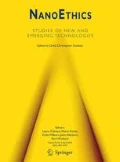Abstract
Many developing countries have allocated significant amounts of funding for nanoscience and nanotechnology research, yet compared to developed countries, there has been little study, discussion, or debate over social and ethical issues. Using in-depth interviews, this study focuses on the perceptions of practitioners, that is, scientists and engineers, in one developing country: India. The disciplinary background, departmental affiliation, types of institutions, age, and sex of the practitioners varied but did not appear to affect their responses. The results show that 95% of the Indian practitioners working in the area of nanoscience and nanotechnology research recognized ethical issues in this research area, and 60% of them could offer specific examples, which included possible ill effects on environment and human, use as a weapon, hype, professional ethics, laboratory testing on animals, cyborgs, widening the gap between rich and poor, self-replication, and longevity of human life. The results may offer opportunities for future cross-cultural research, as well as offer examples that can be used to raise the awareness of other practitioners in India and elsewhere regarding the importance of ethical issues.

Similar content being viewed by others
Notes
In the USA, the Defense Advanced Research Projects Agency (DARPA) has a ‘Hybrid Insect- Micro- Electro- Mechanical Systems’ (HI-MEMS) program, which aims to implant and place MEMS inside insects such as moths and beetles during the early stages of metamorphosis. That way, as the bugs mature, tissues grow around and fuse together with the nano machines. This is popularly known as ‘cyborg insects’. The program is aimed to develop technology that provides more control over insect locomotion, just as saddles and horseshoes are needed for horse locomotion control. Due to the small size of anything related to nano, the issue of surveillance becomes imperative. This kind of project already exists and there bound to be ethical concerns if this technology falls in wrong hands. For further information on the project please visit http://www.darpa.mil/mto/programs/himems, accessed on August 10, 2009.
References
Bhabra G, Sood A, Fisher B, Cartwright L, Saunders M, Evans WH, Surprenant A, Lopez-Castejon G, Mann S, Davis SA, Hails LA, Ingham E, Verkade P, Lane J, Heesom K, Newson R, Case CP (2009). Nanoparticles can cause DNA damage across a cellular barrier. Nature Nanotechnology. Published online November 5, 2009, and retrieved from http://www.nature.com/nnano/journal/vaop/ncurrent/abs/nnano.2009.313.html
Crichton M (2002) Prey. HarperCollins Publishers, London
Dhawan A, Taurozzi JS, Pandey AK, Shan W, Miller SM, Hashsham SA, Tarabara VV (2006) Stable colloidal dispersions of C60 fullerenes in water: evidence for genotoxicity. Environ Sci Technol 40:7394–7401
Gilbert N (2009) Nanoparticiple safety in doubt. Nature 460:937
Giles J (2005) Taking on the cheats. Nature 435:258–259
Godman M (2008) But is it unique to nanotechnology? Sci Eng Ethics 14:391–403
Hughes J (2004) Citizen cyborg: why democratic societies must respond to the redesigned human of the future. Westview Press, Cambridge
Hunt G (2007) The global ethics of nanotechnology. In: Hunt G, Mehta MD (eds) Nanotechnology: risk, ethics and law. Earthscan, London, pp 183–195
Kjølberg K, Wickson F (2007) Social and ethical interactions with nano: mapping the early literature. Nanoethics 1:89–104
Maynard AD, Aitken RJ, Butz T, Colvin V, Donaldson K, Oberdörster G, Philbert MA, Ryan J, Seaton A, Stone V, Tinkle SS, Tran L, Walker NJ, Warheit DB (2006) Safe handling of nanotechnology. Nature 444:267–269
McGinn R (2008) Ethics and nanotechnology: views of nanotechnology researchers. Nanoethics 2:101–131
Mnyusiwalla A, Daar AS, Singer PA (2003) Mind the gap: science and ethics in nanotechnology. Nanotechnology 14:R9–R13
Moor JH, Weckert J (2004) Nanoethics: assessing the nanoscale from an ethical point of view. In: Baird D, Nordmann A, Schummer J (eds) Discovering the nanoscale. IOS Press, Amsterdam, pp 301–310
Moore AJ, Parker RJ, Wiggins J (2008) Malignant mesothlioma. Orphanet J Rare Dis 3(34)
Myllynen P (2009) Nanotoxicology: damaging DNA from a distance. Nat Nanotechnol 4:795–796
Nel A, Xia T, Mädler L, Li N (2006) Toxic potential of materials at the nanolevel. Science 311:622–627
Nordmann A, Rip A (2009) Mind the gap revisited. Nat Nanotechnol 4:273–274
Nordmann A (2004) Molecular disjunctions: staking claims at the nanoscale. In: Baird D, Nordmann A, Schummer J (eds) Discovering the nanoscale. IOS Press, Amsterdam, pp 51–62
Oberdorster E (2004) Fullerenes and fish brains. Environ Health Perspect 112:A 568
Patra D, Haribabu E, Basu PK (2009) Nanoscience and nanotechnology: ethical, legal, social and environmental issues. Curr Sci 96(5):651–657
Royal Society and Royal Academy of Engineering (2004) Nanoscience and nanotechnologies: opportunities and uncertainties. Royal Society, London
Schummer J (2007) Identifying ethical issues of nanotechnologies. In: ten Have HAMJ (ed) Nanotechnology: science, ethics and politics. UNESCO, Paris, pp 79–98
Singer P, Salamanca-Buentello F, Daar AS (2005) Harnessing nanotechnology to improve global equity. Issues Sci Technol 21:57–64
Strauss A (1987) Qualitative analysis for social scientists. Cambridge University Press, Cambridge
Sweeney AE, Seal S, Vaidyanathan P (2003) The promises and perils of nanoscience and nanotechnology: exploring emerging social and ethical issues. Bull Sci Technol Soc 23:236–245
Weil V (2003) Zeroing in on ethical issues in nanotechnology. Proc IEEE 91:1976–1979
Acknowledgements
We are thankful to the Indian scientists and engineers, who participated in this study, for their valuable time and opinions. We thank Prof. Prajit K. Basu, Department of Philosophy, University of Hyderabad for his contribution to this study. We thank Dr. Abani K. Pradhan for providing valuable insights to draft versions of this paper. We thank Michael Skavarla of Cornell NanoScale Science and Technology Facility, Cornell University for introducing the concept of ‘cyborg insects’ to us. We are also thankful to the anonymous reviewers for their suggestions.
Author information
Authors and Affiliations
Corresponding author
Rights and permissions
About this article
Cite this article
Patra, D., Haribabu, E. & McComas, K.A. Perceptions of Nano Ethics among Practitioners in a Developing Country: A Case of India. Nanoethics 4, 67–75 (2010). https://doi.org/10.1007/s11569-010-0086-7
Received:
Accepted:
Published:
Issue Date:
DOI: https://doi.org/10.1007/s11569-010-0086-7




